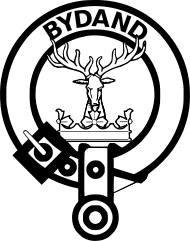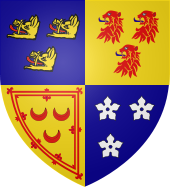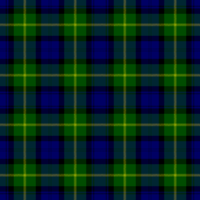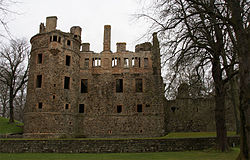- Clan Gordon
-
Clan Gordon Crest badge 
Crest: Issuant from a crest coronet Or a stag's head (affrontée) Proper attired with ten tines Or Motto: Bydand (abiding, steadfast, an adjectival use of the Middle Scots present participle of bide[1] or a contraction of the Scots phrase 'Bide and Fecht,' meaning to stand and fight.)[2][3]
Animo non Astutia (By Courage not by craft)[4]Slogan: An Gordonach War cry: A Gordon! A Gordon![5] Profile Region Highland District Aberdeenshire Plant badge Rock Ivy Pipe music "The Gordon's March", "Cock o' the North" Gaelic name Gordanach (Singular), Na Gordanaich (Collective). Chief

The Most Hon. Granville Charles Gomer ordon The 13th Marquess of Huntly Seat Aboyne Castle[6] Historic seat Huntly Castle Septs of Clan Gordon Ackane, Adam(son), Ad(d)i.e., Addison, Adkins, Aiken, Aitchison, Aitken, Akane, Akins, Anderson, Atkin, Atkins(on), Badenoch, Barrie, Connor, Connon, Coyle, Craig, Cromb(i.e.), Cullen, Culane, Darg(e), Dorward, Duff, Durward, Eadie, Ed(d)i.e., Edison, Esslemont, Garden, Gard(i)ner, Garioch, Garr(o)ick, Geddes, Gerr(y)ie, Harrison, Haddo(w), Huntl(e)y, Jeffrey, Jessiman, Jopp, Jupp, La(i)ng, Laurie, Lawrie, Leng, Ling, Long, MacAdam, MacGwyverdyne, Mallett, Manteach, Marr, Maver, McGonigal, Meldrum, Mill, Mills, Milles, Miln(e)], Milner, Moir, More, Morrice, Muir, Milnes, Mylne, Pittendri(e)gh, Shellgren, Steel(e), Teal, Tod(d), Troup Clan branches Gordon of Huntly (chiefs)
Gordon of Haddo
Gordon of Lochinvar
Gordon of Strathbogie
See also:
Gordon BaronetsAllied clans Clan Seton
Clan Sutherland
Clan BurnettRival clans Clan Lindsay
Clan Douglas
Clan ForbesClan Gordon, also known as the House of Gordon, is a Scottish clan. The chief of the clan was the powerful Earl of Huntly, now also Marquess of Huntly.
Contents
History
Origins
The first Gordon on record is Richard of Gordon, previously of Swinton, said to have been the grandson of a famous knight who slew some monstrous animal in the Merse during the time of King Malcolm III of Scotland. This Richard was Lord of the Barony of Gordon in the Merse. Between 1150 and 1160 he granted from his estate a piece of land to the Monks of St. Mary at Kelso, a grant which was confirmed by his son Thomas Gordon. Other notable Gordons from this time include Bertram de Gordon who wounded King Richard of England with an arrow at Châlons.[7]
Alicia Gordon, IV of the Gordon family was the heiress who married her cousin, Adam Gordon. Adam Gordon was a soldier who King Alexander III of Scotland sent with King Louis of France to Palestine. One tradition is that from Adam's grandson, Sir Adam all of the Gordons in Scotland are descended from.* This Adam Gordon supported Sir William Wallace in 1297 to recapture the Castle of Wigtown from the English and Adam was made the Governor.[7]
- According to Professor J D Mackie, in "A History of Scotland", page 109, "...the Earl of Huntly was head of the Gordons, but by no means all the 150 houses which claimed the name of Gordon were sprung from the loins of his ancestor..."
Wars of Scottish Independence
During the Wars of Scottish Independence Sir Adam Gordon who had supported William Wallace later supported Robert the Bruce. Adam was killed leading the Clan Gordon at the Battle of Halidon Hill in 1333 but his son Sir Alexander Gordon escaped and was the first Gordon to be designated "of Huntly".[7]
Chief Sir John Gordon was killed leading the clan at the great Battle of Otterburn, where the English were defeated in 1388. His son, Chief Sir Adam Gordon was killed leading the clan at the Battle of Homildon Hill, also known as the Battle of Humbleton Hill on 14 September 1402. The chief left his only child, a daughter named Elizabeth Gordon who married Alexander Seton, who was the son of Sir William Seton the chief of Clan Seton.[7]
15th century and clan conflicts
The Battle of Arbroath was fought in 1445, Patrick Gordon of Methlic, cousin of the Earl of Huntly was killed fighting the Clan Lindsay. From Patrick the Earls of Aberdeen descend.[7][8]
In 1449 The Gordons defeat the Clan Douglas who had invaded their lands. The Douglases were enemies of the King. The Gordons stood on the king's side, and with their men involved in the south of the country, the Earl of Moray, a relation and ally of the Douglases, took the opportunity to sack the Gordon lands, setting Huntly Castle ablaze. The Gordons returned and quickly destroyed their enemies. Although the castle was burned to the ground, a grander castle was built in its place. Also in 1449, Alexander Gordon, 1st Earl of Huntly, the eldest son of Elizabeth Gordon and Alexander Seton, was made chief, Lord of Gordon and Huntly. However, his male heirs through his third wife Elizabeth Crichton were obliged to bear the name of Gordon to succeed as chiefs of the clan.[7]
The chief of Clan Lindsay Alexander Lindsay, the 4th Earl of Crawford, also known as the Tiger Earl and Earl Beardie was badly defeated by the Clan Gordon and Clan Ogilvy under the Earl of Huntly at the Battle of Brechin in 1452.[7]
16th century and clan conflicts
In 1513, during the Anglo-Scottish Wars, the Clan Gordon led by Alexander Gordon, 3rd Earl of Huntly fought at the Battle of Flodden Field.[7]
During the 15th and 16th centuries the Clan Gordon was engaged in a long feud against Clan Forbes. The feud which had been carried on for a long time reached a climax in the 1520s with murders committed by both sides occurring constantly. One of the most prominent of those killed by the Forbes action, Seton of Meldrum, was a close connection of the chief of the Gordons, the Earl of Huntly. The Earl of Huntly soon became involved in a plot aimed at the Master of Forbes (son of John, the 6th Lord Forbes), who was heavily implicated in the Seton murder.
In 1526 the title of Earl of Sutherland and chieftenship of the Clan Sutherland passed by right of marriage to Adam Gordon who was a younger son of the chief of Clan Gordon of Huntly.
In 1536 Chief of Gordons, the Earl of Huntly accused the Master of Forbes of conspiring to assassinate King James V of Scotland while visiting Aberdeen by shooting at him with a cannon. The Master of Forbes was tried and executed, but within days his sentence was revoked and the Clan Forbes family restored to favour. However the damage to relations between the Clan Forbes and Clan Gordon was irreparable. Attacks by each family and their supporters were carried out more or less continuously throughout the remainder of the century, reducing Aberdeenshire to an unparalleled state of lawlessness.
During the Anglo-Scottish Wars the Clan Gordon, under George Gordon, 4th Earl of Huntly defeated an English army at the Battle of Haddon Rig in 1542. Later during the Anglo-Scottish Wars the Clan Gordon fought in the Scottish army which was defeated at the Battle of Pinkie Cleugh in 1547.[7]
Chief George Gordon, 4th Earl of Huntly was General of the forces on the Borders who opposed the forces of Henry VIII of England and Gordon had many victorious encounters. He was however later killed at the Battle of Corrichie in 1562 fighting against the forces of James Stuart, Earl of Moray (half-brother to Mary Queen of Scots). Gordon was killed and his son, Sir John, and other members of his family were later executed at Aberdeen.[7]
During the 15th and 16th centuries the clan was engaged in a long and bitter struggle against the Clan Forbes. By 1571 the feud had got to the point where other clans began taking sides. The Clan Leslie, Clan Irvine and Clan Seton who had their own feuds with the Forbeses joined forces with Clan Gordon. However opponents of the Gordons such as Clan Keith, Clan Fraser and Clan Crichton joined forces with Clan Forbes. The feud culminated in two full scale battles in 1571; The Battle of Tillieangus and the Battle of Craibstone. Also in 1571 Castle Druminnor, then Lord Forbes's seat, was itself plundered and sacked and in the same month the Gordons followed this up by the atrocious massacre of 27 Forbeses of Towie at Corgarff. Two acts of Parliament were required to force the clans to lay down their arms but the struggle had drawn the Forbeses deep into debt making it necessary for them to sell much of their land.[9][10][7]
At the Battle of Glenlivet in 1594 the Earl of Argyll's forces which consisted of Clan Campbell, Clan Stewart of Atholl, Clan Forbes and the Chattan Confederation of Clan MacKintosh were defeated by the Earl of Huntly's forces which consisted of Clan Gordon, Clan Comyn/Cumming and Clan Cameron.[11][7]
17th century and Civil War
Between 1615 and 1616 there appears to have been a disagreement of some sort between the Gordons and the neighboring Clan Leask. In all the recorded cases the Gordons appear to have been the aggressors; Adam Gordon, brother of the Laird of Gight assaulted Alexander Leask, then the son of the chief was attacked by George Gordon and finally William Leask of that Ilk was ambushed by John Gordon of Ardlogy and a party of armed men.[7]
In 1644 Alexander Bannerman of Pitmedden fought a duel with his cousin, Sir George Gordon of Haddo, and wounded him. Also in 1644 during the Civil War at the Battle of Aberdeen there were Gordons on both sides. Lord Lewis Gordon led his forces on the side of the Covenanters while Sir Nathaniel Gordon led his forces in support of the Royalists.[7]
Later the Civil War cavalry from the Clan Gordon fought in support of the royalist James Graham, 1st Marquess of Montrose at the Battle of Auldearn where they helped defeat the Covenanters of Lord Seaforth who was the chief of Clan Mackenzie. The battle took place on 9 May 1645. The Clan Gordon fought at the Battle of Alford in 1645. They are victorious, led by George Gordon, 2nd Marquess of Huntly fighting under James Graham, 1st Marquess of Montrose. The Marquess of Huntly's eldest son George Gordon fell at this battle.[7] Also in 1645, Lewis Gordon, clan chief and 3rd Marquess of Huntly of the Clan Gordon attacks and burns down Brodie Castle of the Clan Brodie. This was part of the Covenanting conflict during the Civil War.[7]
In 1682 a fight took place over cattle and land with the southern Scottish family the MacCulloch's of Myreton. Following the fatal fight, Sir Godfrey Macculloch fled the country for a time, but returned, only to be apprehended and executed in 1697.
In the early 17th century Clan Gordon had a number of alliances by marriage or friendship. Among these was a strong bond to the Clan Burnett of Leys. The Gordon crest is emblazoned in plasterwork on the ceiling of the early 17th century great hall of Muchalls Castle built by Alexander Burnett.[7]
18th century and Jacobite risings
In 1715 the fighting force of the Clan Gordon is given by General George Wade as 1000 Claymores.[7] During the Jacobite Uprisings of 1715 – 1716 and 1745 – 1746 there were Gordons on both sides. The 2nd Duke of Gordon followed the Jacobites in 1715, but Cosmo Gordon, 3rd Duke of Gordon supported the British government by the time of the 1745 uprising. On the other hand his brother, Lord Lewis Gordon, raised two regiments against the Hanoverians, and they fought at the Battle of Inverurie (1745), the Battle of Falkirk (1746) and the Battle of Culloden (1746).[7]
British Army regiments
Two regiments named the "Gordon Highlanders" have been raised from the Clan Gordon. The first was the "81st" formed in 1777 by the Hon. Colonel William Gordon, son of the Earl of Aberdeen and was disbanded in 1783. The second was the "92nd" raised by the Marquess of Huntly in 1794.[7]
Chief and arms
- The Chief of Clan Gordon is Granville Charles Gomer Gordon, 13th Marquess of Huntly, (Earl of Huntly?), Earl of Enzie, Earl of Aboyne, Lord Gordon of Badenoch, Lord Gordon of Strathavon and Glenlivet, Baron Meldrum of Morven.[12]
- The Chief of Clan Gordon is known as: The Cock o' the North.[13][14]
- Chief's Arms: Quarterly, 1st Azure, three boars’ heads couped Or, Proper langued Gules (for Gordon), 2nd, Or three lions heads erased Gules langued Azure (for Lordship of Badenoch), 3rd, Or, 3 crescents within a Royal Tressure, flory counter flory, Gules (for Seton), 4th, Azure three fraises Argent (for Fraser, acquisition of the Aboyne lands)[15]
Tartans
 Gordon tartan, as published in the Vestiarium Scoticum of 1842.[16] The tartan is based upon the Black Watch tartan.
Gordon tartan, as published in the Vestiarium Scoticum of 1842.[16] The tartan is based upon the Black Watch tartan.
Clan Gordon has several recognized tartans:
- Gordon (Modern)
- Gordon (Dress)
- Gordon (Ancient)
- Gordon (Weathered)
- Gordon (Muted)
- Gordon (Red)
The Gordon Modern tartan was used by The Gordon Highlanders, (now The Highlanders (4th Battalion, Royal Regiment of Scotland)) and is sometimes referred to as "Military". The tartan itself is based on the Black Watch military tartan with an additional yellow stripe. The difference between the family sett (modern) and military sett is only in the pleating of the kilt. The military pleat to the stripe, showing a series of stripes across the back of the kilt. The family sett is pleated to the sett, showing the repeat of the pattern in its entirety across the back of the kilt. The Red Gordon tartan is sometimes referred to as "Huntly".
The Gordon Modern tartan was used for many years as the troop tartan for the 10th Finchley (Scottish) Scout Group, London N3.[citation needed]
Castles
- Huntly Castle was the seat of the chief of Clan Gordon from at least the 14th century until the late 17th century.
- Balmoral Castle was sold to Alexander Gordon, the 3rd Earl of Huntly, in the 15th century.
- Castle Craig, or the Craig of Auchindoir, is located on the edge of Aberdeenshire's "wild west", between Lumsden and Rhynie.
- Auchindoun Castle was awarded to the Marquis of Huntly in 1535.
- Gordon Castle was built in 1789 for the 4th Duke of Gordon, becoming the new seat for the chief of Clan Gordon.
- Fyvie Castle was owned by several Gordons between the 18th and 19th century.
See also
- Marquess of Aberdeen and Temair
- Duke of Gordon
- Lord Byron {George Gordon Byron, 6th Baron Byron}
- Gordon Riots
Notes and references
- ^ SND: Bydand
- ^ A Dictionary of Mottoes; p.27; By Leslie Gilbert Pine; Published by Routledge, 1983; ISBN 071009339X, ISBN 9780710093394
- ^ "What does Bydand mean?". The Gordon Highlanders - Bydand.net. http://www.bydand.com/motto.htm. Retrieved 31 July 2010.
- ^ A Dictionary of Mottoes; p.13; By Leslie Gilbert Pine; Published by Routledge, 1983; ISBN 071009339X, ISBN 9780710093394
- ^ The Scottish clans and their tartans
- ^ clanchiefs.org
- ^ a b c d e f g h i j k l m n o p q r s t "The Scottish Clans and Their Tartans". W. & A. K. Johnston Limited. Edinburgh and London. 1886. Page 25.
- ^ http://web.archive.org/web/20091027094723/http://www.geocities.com/clanoliphant/arbroath.html
- ^ http://canmore.rcahms.gov.uk/en/site/17720/details/battle+of+tillyangus/
- ^ http://canmore.rcahms.gov.uk/en/site/20119/details/aberdeen+crabe+stone/
- ^ http://www.clan-cameron.org/battles/1594.html
- ^ http://www.burkes-peerage.net/familyhomepage.aspx?FID=0&FN=HUNTLY burkes-peerage.net
- ^ The Ballad and the Folk; By David Buchan
- ^ The History of Scotland; By Peter Somerset Fry, Fiona Somerset Fry, Rosalind Mitchison
- ^ "houseofgordon.com ARMS". http://www.houseofgordon.com/ARMS.html.
- ^ Scotland's Forged Tartans, p.68
External links
- The House of Gordon USA Official website for the House of Gordon USA this site is an active society site with information on the various Divisions.
- The House of Gordon Virginia Division largest Gordon website online, this site is an active society site with constant updates and news.
- The House of Gordon Midwest website with information and current US events.
- Gordon DNA testing
- The House of Gordon Australia
Scottish clans Clans with chiefs Agnew · Anstruther · Arbuthnott · Arthur · Bannerman · Barclay · Borthwick · Boyd · Boyle · Brodie · Broun · Bruce · Buchan · Burnett · Cameron · Campbell · Carmichael · Carnegie · Cathcart · Charteris · Chattan · Chisholm · Cochrane · Colquhoun · Colville · Cranstoun · Crichton · Cumming · Darroch · Davidson · Dewar · Drummond · Dunbar · Dundas · Durie · Elliot · Elphinstone · Erskine · Farquharson · Fergusson · Forbes · Forsyth · Fraser · Fraser of Lovat · Gayre · Gordon · Graham · Grant · Gregor · Grierson · Guthrie · Haig · Haldane · Hamilton · Hannay · Hay · Henderson · Home · Hope · Hunter · Irvine · Jardine · Johnstone · Keith · Kennedy · Kerr · Kincaid · Lamont · Leask · Lennox · Leslie · Lindsay · Lockhart · Lumsden · Lyon · MacAlister · MacBain · MacDonald · Macdonald of Clanranald · MacDonald of Keppoch · Macdonald of Sleat · MacDonell of Glengarry · MacDougall · Macdowall · MacIntyre · Mackay · Mackenzie · Mackinnon · Mackintosh · Maclachlan · Maclaine of Lochbuie · MacLaren · MacLea (Livingstone) · Maclean · MacLennan · MacLeod · MacLeod of Lewis · MacMillan · Macnab · Macnaghten · MacNeacail · MacNeil · Macpherson · MacTavish · MacThomas · Maitland · Makgill · Malcolm (MacCallum) · Mar · Marjoribanks · Matheson · Menzies · Moffat · Moncreiffe · Montgomery · Morrison · Munro · Murray · Napier · Nesbitt · Nicolson · Ogilvy · Oliphant · Primrose · Ramsay · Rattray · Riddell · Robertson · Rollo · Rose · Ross · Ruthven · Sandilands · Scott · Scrymgeour · Sempill · Shaw · Sinclair · Skene · Spens · Stirling · Strange · Stuart of Bute · Sutherland · Swinton · Trotter · Urquhart · Wallace · Wedderburn · Wemyss · Wood ·
Armigerous clans Abercromby · Abernethy · Adair · Adam · Aikenhead · Ainslie · Aiton · Allardice · Anderson · Armstrong · Arnott · Auchinleck · Baillie · Baird · Balfour · Bannatyne · Baxter · Bell · Belshes · Bethune · Beveridge · Binning · Bissett · Blackadder · Blackstock · Blair · Blane · Blyth · Boswell · Brisbane · Buchanan · Butter · Byres · Cairns · Calder · Caldwell · Callender · Campbell of Breadalbane · Campbell of Cawdor · Carruthers · Cheyne · Chalmers · Clelland · Clephane · Cockburn · Congilton · Craig · Crawford · Crosbie · Cunningham · Dalmahoy · Dalrymple · Dalzell · Dennistoun · Don · Douglas · Duncan · Dunlop · Edmonstone · Fairlie · Falconer · Fenton · Fleming · Fletcher · Forrester · Fotheringham · Fullarton · Galbraith · Galloway · Gardyne · Gartshore · Ged · Gibsone · Gladstains · Glas · Glen · Glendinning · Gray · Gunn · Haliburton · Halkerston · Halket · Hepburn · Heron · Herries · Hogg · Hopkirk · Horsburgh · Houston · Hutton · Inglis · Innes · Kelly · Kinloch · Kinnaird · Kinnear · Kinninmont · Kirkcaldy · Kirkpatrick · Laing · Lammie · Langlands · Learmonth · Little · Logan · Logie · Lundin · Lyle · MacAulay · Macbrayne · MacDuff · MacEwen · MacFarlane · Macfie · Macgillivray · MacInnes · MacIver · Mackie · MacLellan · Macquarrie · Macqueen · Macrae · Masterton · Maule · Maxton · Maxwell · McCorquodale · McCulloch · McKerrell · Meldrum · Melville · Mercer · Middleton · Moncur · Monteith · Monypenny · Mouat · Moubray · Mow · Muir · Murray of Atholl · Nairn · Nevoy · Newlands · Newton · Norvel · Ochterlony · Orrock · Paisley · Paterson · Pennycook · Pentland · Peter · Pitblado · Pitcairn · Pollock · Polwarth · Porterfield · Preston · Pringle · Purves · Rait · Ralston · Renton · Roberton · Rossie · Russell · Rutherford · Schaw · Seton · Skirving · Somerville · Spalding · Spottiswood · Stewart · Stewart of Appin · Strachan · Straiton · Strange · Sydserf · Symmers · Tailyour · Tait · Tennant · Troup · Turnbull · Tweedie · Udny · Vans · Walkinshaw · Wardlaw · Watson · Wauchope · Weir · Whitefoord · Whitelaw · Wishart · Young
Culture and society Scotland · Clan chief · Septs · Clan badge · Clan crest · Clan battles · Tartan · Bagpipes · Clearances · Kilt · Manrent · The Highlands · Battle of Culloden · Highland games · Border Reivers · Scottish heraldry · Scottish surnames
Categories:- Scottish clans
- Scoto-Norman clans
Wikimedia Foundation. 2010.

